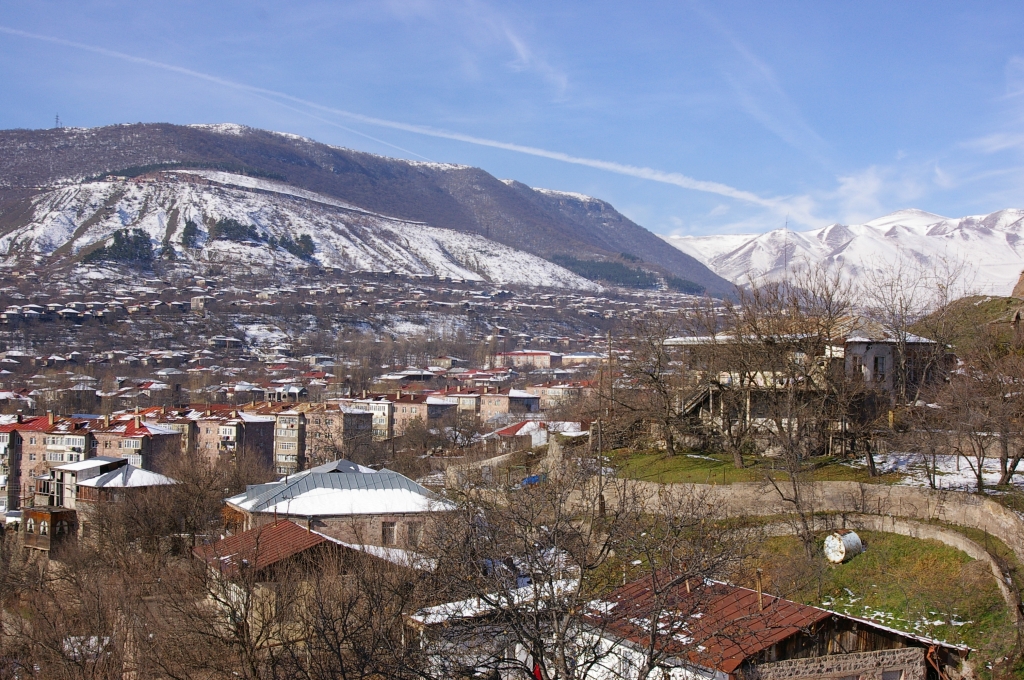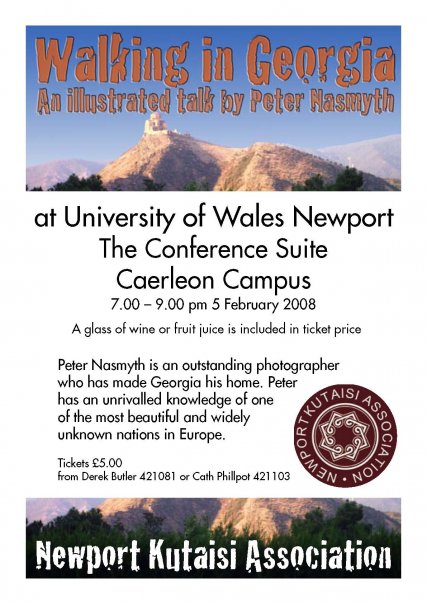TRACKING THE COMPLEXITIES OF THE CAUCASUS1/18/08 A Book Review by Alex van Oss (www.eurasianet.org)
The Ghost of Freedom: A History of the CaucasusBy Charles King2008 Oxford Press, 291 p., ISBN: 978-0-19-517775-6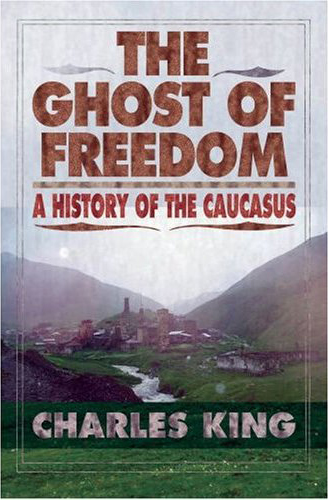
Most Caucasus writing these days is either journalistic or academic, obsessed for the most part with conflicts or oil. The Ghost of Freedom manages to break the mold: Charles King, a professor of government and international affairs at Georgetown University, has produced a work that is at once informative, eclectic, and immensely satisfying.
In fewer than 300 pages King provides a comprehensive and gracefully written account of the South and North Caucasus, plus Black Sea regions of Russia, such as Sochi, site of the 2014 Winter Olympics.
Excellent maps by Chris Robinson depict political boundaries of 1780, 1890, and 2008, showing dramatically how Persian or Ottoman territory one century became Russian the next, and now, independent. The title, "The Ghost of Freedom," comes from Pushkin’s 1821 poem "Captive of the Caucasus" whose Byronic protagonist, tiring of Mother Russia,
"...quit the confines of his native land, and flew away to a far off strand with freedom’s cheerful apparition..."… Or its illusion. The hero gets captured by locals, finds romance, and then escapes. The poem inspired sundry other stories, operas, a ballet, a book, plus a film or two--all with the same title; and it prompted thousands of restless Russians to "go West" (go south, that is) and seek love, profit, epiphany, and adventure in the mountains.
***
So much for Pushkin. When pondering this seductive part of the world, it is useful to keep a couple of points in mind; first, the Caucasus is not Russia, and second, Russia is not the Caucasus. The Ghost of Freedom explains why the region is no longer the "jewel in the crown," or a proving ground for a Big Brother; nor can it in any way be considered a single political entity. Rather, its extremely variegated terrain also harbors distinct cultural ecosystems that at various times have been called a "museum of mankind," a "mountain of tongues," and even a "sculpture" (see below), with a bewildering array of languages, ethnicities, and views of history.
Indeed, the Caucasus can be likened to the classic children’s finger-puzzle in which 15 little sliding squares, enclosed in a frame, must be reconfigured in correct sequence. This is devilishly hard to do. In the living puzzle of the Caucasus there are of course many more pieces, which King rearranges in various illuminating ways, while neatly summarizing vast amounts of history.
King begins at the beginning, 25 million years ago, with the collision of continents that forced up most of the mountain ranges of Eurasia, including the Caucasus and its deposits of oil and gas. (By the way, this geological train-wreck is still in progress, albeit in extremely slow motion.) There has been much cultural as well as tectonic grinding in the Caucasus over the centuries. Scores of indigenous peoples and invaders have collided, traded, and genetically intermingled, leaving remnants and pockets of themselves in valleys, among alpine meadows, and in isolated auls (aerie-like highland villages) between the Black and Caspian Seas. The Caucasus has paid the price of being a cultural crossroads, and has weathered incursions from every quadrant: Persians from the southeast; Greeks and Romans (plus Byzantines, Arabs, Ottomans, and Turks) from the southwest; Huns, Avars, Mongols (and Russians, British, Germans, and so forth) from the north. The result--as cartographers soon discover to their dismay -- is what King describes as "borders on the move" (a concept reminiscent of certain ancient Caucasus legends that describe a time when the mountains could actually walk around...on ’legs’ of clouds!)
Maps are never the territory, of course, but King’s "surfeit of borders" precisely describes a neck of land historically chock-a-block with feudal clans and feuding vassalages, suzereinties, satrapies, and client states--and their shifting alliances. Add to this the poking and prodding by great powers and no wonder Caucasus politics displays a certain operatic quality (Bolshevik Revolution here, Rose Revolution there, charming folk dances and drinking songs over yonder, while oil wheeler-dealers and ’frozen conflict peacekeepers’ wait in the wings). Readers of The Ghost of Freedom will perhaps not be surprised to learn that the maneuvering continues, the United States being but the latest partner (or padrone) active in the South Caucasus. Tomorrow--who knows?--that role may revert to Russia, Turkey, or even China, and once again we would need to redraw the maps.
***
Today’s nations can be old or spanking new. Azerbaijan, King writes, is only a 20th-century construct; but even ancient entities such as Georgia and Armenia can wink on and off over the centuries:
"Two hundred years ago the map of the Caucasus looked very different from the one that exists today. Unified places called Georgia and Armenia had long ago disappeared, the former in the fifteenth century, and the latter in antiquity. Both were geographical rather than political expressions. A place called Azerbaijan, when the term was used at all, was more likely to refer to what one would now call northwestern Iran [p. 14-15].
"Modern maps that show great swaths of colored territory as clearly belonging to one or another khanate, kingdom, principality, or empire are fundamentally misleading about the real nature of sovereignty on the ground. The goal of any political power was to control the locus of extraction, such s a key bridge, port, mountain pass, or fortress. When borders did serve something like a modern purpose, they were usually meant not to keep people out but to keep them in." [ p.21]
The photographs in this volume are subtle and bear close examination. Two poignant images from the Library of Congress depict victims of war and massacres in 1919: one shows a row of Armenian orphans (bareheaded, barefoot), the other a similarly posed rank of Muslim/Turkish orphans (shod, hatted, holding staves). A 1935 photograph from the Hoover Institution Archives portrays Stalin’s henchman, Lavrenty Beria, standing next to three colleagues from Armenia, Abkhazia, and Azerbaijan. In retrospect it is a chilling artifact, for the following year the Armenian and Abkhazian would die under unusual circumstances after meeting with Beria (expiring by ’suicide’ and spasms, or possibly a ’heart-attack,’ respectively); the Azerbaijani was liquidated three years later. The Caucasus can be unkind to its own.
Battle and treaty dates can make for notoriously tedious reading; happily King manages to quick-march through history with panache, pausing frequently to clarify events and their wider implications (which events in the Caucasus always have). He also de-romanticizes the region:
"The legendary horsemanship and daring of Caucasus fighters were acknowledged even by their enemies. Russian painters depicted engagements between [Russian allied] Cossacks-of-the-line and their Circassian and Daghestani counterparts, with riders galloping at full tilt toward one another, meetings with the clash of saber and lance. However, such engagements were probably the exception rather than the rule. The Caucasus wars were always partly guerilla campaigns--what would today be called seasonal counterinsurgency operations. They rarely involved anything approximating pitched battles, at least of the type that Russian officers and men knew from their wars with other empires." [p.73]
The world learned about the Caucasus from travel accounts, 19th century Russian writers (Pushkin, Lermontov, Tolstoy, and others), and from press coverage of the long wars between highlanders and tsarist armies. To this must be added the allure of show business: Buffalo Bill Cody featured "Cossack" horsemen--actually Georgians--in his Wild West Show, while P.T. Barnum hawked "Circassian Beauties" (Irish, perhaps) as sideshow attractions. Exotic representations of the Caucasus continue to this day: John le Carré’s spy-thriller Our Game takes readers to some of the wilder-and-woolier parts of southern Russia; and John Ringo has a popular series of science fiction novels set in eastern Georgia: Ghost, Kildar, Choosers of the Slain, Unto the Breach.
The Caucasus was home to early Christian and Muslim states, and even earlier Jewish and Zoroastrian communities; paganism, once widespread, continues to exist. While never a paragon of tolerance, the Caucasus has avoided "clashes-of-civilizations"--although imperial Russia periodically used religion in its recruitment of Armenians to fight the Ottomans, and radical imams sought to unite the North Caucasus in jihad against the Russian advance. But somehow the spark never caught fire, due in part to the region’s heterogeneity. This was its strength and also its weakness. King describes the tsarist strategy of dividing and conquering the Caucasus by way of its geographical "flanks" (corresponding roughly to the Caspian and Black Sea watersheds):
"The middle ground... between the right and the left flanks was also home to a variety of peoples, some of whom were loyal to the tsar, while others lived in out-of-the-way areas and consequently posed no immediate threat to imperial power. Among the latter groups were the Turkic-speaking Karachai and Balkars; the Ossetians, whose villages helped insulate the road against highlander attacks; and the peoples of mountainous Georgia, the Svans, Khevsurs, Pshavs, and Tush. The great dream of some highland leaders was to unite the two flanks, which were separated by no more than 150 miles, into a single front. The great success of Russian policy was that it prevented them from ever doing so." [p.68]
The quaint term "Caucasian," as an ethnic category, harks back to Johann Friedrich Blumenbach’s On the Natural Variety of Mankind (1775), in which the German physician tried to link physical characteristics (such as skull size) to culture. Blumenbach considered Caucasians to be the world’s most ancient--and beautiful--white people. (Caucasians actually come in all shapes, sizes, and hues of hair and skin color.) Ethnography has often been politicized, and in the Caucasus Russian and Soviet academics demonstrated what King calls the "Enlightenment urge to taxonomize." As King puts it, Russian popular imagination fed upon the works of writers and painters (sometimes one and the same, as with Mikhail Lermontov), who in turn fed on volumes of ethnography. Their curiosity was wide and deep; King includes the instructions from the St. Petersburg imperial academy to a German explorer, Julius von Klaproth, in 1807; the academy wanted to know:
"Are there traditions respecting the existence of Amazons? Who are the likely descendants of the Scythians, the ancient steppe dwellers described by Herodotus? Where are the passes in the mountains? What is to be found in the districts south of the highlands, especially along the black Sea? What s the word for "tribe" in the Lezgin dialects? Are the women of the Caucasus as beautiful as is often claimed?" [p.104]
Another scholar, Semyon Bronevskii, toiled for years over a massive two-volume overview of earlier explorers’ notes, all the while working at administrative posts. The fruits of his labor, titled The Latest Geographical and Historical Information on the Caucasus, brought the Caucasus out of academia and into Russian consciousness--and King continues this tradition for western readers.
***
The Ghost of Freedom perforce covers a lot of ground. Divided into five chapters, the book describes geology and geography; imperial and colonial designs on the Caucasus (and staunch resistance to it); Caucasus ethnography and imagery in popular culture; the Bolshevik, Soviet, and independence periods--and much more. Thirty subsections bear catchy titles, such as "Ermolov Comes!," "There is Something to Be Gained on the Heights," and "Eros and the Circassian."
For the most part it is smooth sailing, but some sections are filled to bursting and dense. Chapter Two, for example, covers the complexities of Islam, Caucasus military strategy, fighting techniques, biographies of imams, Georgia’s bureaucracy, the Circassian diaspora--all fascinating, but a lot to absorb. More headings would have been helpful; as it is, readers will need to rely on the index or write notes in the margins (a shame, for this book is too handsome to mark up).
That said, King certainly writes engagingly: he leavens the narrative with anecdotes and verse, and swoops and soars on his magic Caucasus carpet from region to region and one time period to another. Such verve conveys a marvelous sense of the Caucasus as being almost a work of art, physically and culturally: a natural sculpture, no part of which can be truly understood without awareness of the whole--a whole which underwent considerable modification in the 1800s, as Russian troops fortified, cut down vast forests, and built military highways in order to extirpate resistance.
***
The Ghost of Freedom brings together current research, and also classic works by English, French, German, and Russian adventurers, and scholars. We read of Douglas Freshfield’s epiphanies while climbing in the Caucasus mountains in 1869--epiphany, King points out, being a crucial aspect of climbing in those days that was soon to be overcome by the newer craze of seeking ever greater technological challenges, not just a good view. (This is a pity: I recall my own delight at discovering in my local public library a rare masterpiece of Victorian nature writing by James Bryce, a British parliamentarian and ambassador to the United States. Bryce climbed Mount Ararat in 1876 in one of the earliest ascents on record. It was an arduous adventure; nevertheless Bryce took careful notes and describes every interesting pebble encountered, every geological formation, every species of flora and fauna, and every fog patch, cloud and shift of light. Evidently Lord Bryce carried no camera.)
Charles King offers a wealth of surprising and trenchant perceptions about, for example, the ambiguous role of British officers during the fighting between Russians and highlanders, and the fate of soldiers taken into slavery. There is a long Caucasus tradition of slaves, hostages, deserters, and renegades; the analogy to North America is inescapable: many soldiers in the Caucasus "went Indian" by choice, or by an offer they couldn’t refuse.
Sometimes Caucasus history can seem like musical chairs, and in this regard King tackles a delicate subject: the fact that Georgia, Armenia, and Azerbaijan, despite their ancient artistic and religious heritage, owe a considerable cultural debt to Russia and Europe. Printing, jurisprudence, pedagogy, theater, literature, music, philosophical inquiry, and more: all got a vitamin injection from 19th century graduates of universities in St. Petersburg and abroad. Consider the remarkable British-educated Mikhail Vorontsov, whom Tsar Nicholas I made commander-in-chief of Caucasus forces; he was certainly ruthless, but also cosmopolitan:
"Vorontsov was convinced that the Caucasus needed a genuine political, cultural, and economic center--much as Odessa had become the effective capital of New Russia--and Tiflis was to be it. Parts of the city had remained in ruins since the Persian onslaught of 1795. Vorontsov laid on plans for its rebuilding, creating wide thoroughfares and designing new residential districts...the first drama theaters were established in 1850 and 1851 (one for Georgian plays, another for Russian), and the famous Tiflis opera house was soon inaugurated, complete with an Italian company regularly performing well-known pieces...the booming cultural life in Vorontsov’s Tiflis was a sign of the city’s gradual rise from garrison town to urban imperial outpost." [p.86]Baku was soon to boom as well, thanks to oil; Yerevan had to wait until after the First World War, when its population swelled from the influx of Armenians uprooted from Ottoman Turkey.
***
One of the lesser known chapters of world history concerns the 19th century mass expulsion by Russians of Circassians and other groups from the northwestern Caucasus and Black Sea coast. Highlanders and Abkhaz were forced into Anatolia, the Balkans, and further corners of the Ottoman Empire. Inadequately housed and fed, a great many perished from disease or in storms at sea. Up to 500,000 Caucasus peoples (often labeled as ’Circassians,’ regardless of origin) left in the 1860s; King puts the total from 1859-1878 at 2 million. These deportees resettled and often attained high military and administrative positions in their new homes. From revolutionary Russia and the Middle East, thousands emigrated to Europe and the United States, not infrequently maintaining their traditional vocations and codes of honor, and finding employment in diplomacy, various military or security agencies, and other government services. To this day there are Circassian villages in Turkey, Jordan, Israel, and elsewhere.
The ripple effects of Caucasus politics spread outwards, even to the United States, in the form of business ventures to political misadventures (an Armenian bishop was assassinated in New York in 1933) and political lobbying. Wrangling on Capitol Hill over official United States recognition of an Armenian genocide has, directly or indirectly, ended the career of one American ambassador to Armenia, obstructed the ratification of another, and threatens to be a perennial stone in many peoples’ shoes. On the matter of Ottomans, Armenians, and genocide, King states bluntly:
"In nearly all instances of large-scale violence, state manipulation and local circumstances come together in a contingent, complicated, and ultimately deadly mix. The Armenian genocide was neither explicitly ordered as a single act of violence, nor was it the unavoidable consequence of some ancient quarrel between Muslims and Christians. Rather, it was the result of communal fear, ethnic reprisals, government paranoia, and fitful experimentation with targeted killing as a tool of modern statecraft." [p 197]
King continually reminds us of the multiple dramas unfolding in Anatolia at the turn of the 20th century: the collapse of empires and the formation of new nations, the First World War, the brutality and chaos of times a-changing, and the eruption of local antagonisms into something widespread and genocidal. Such a saga ought to inspire great novels, films, and television series--of the scope and subtlety, say, of Paul Scott’s The Raj Quartet, about the final years of British rule in India--but they have yet to appear.
***
The last part of The Ghost of Freedom brings us into the present, and shows how today Caucasus is of a piece with the region in earlier times, and how post-Soviet changes have been a mixed blessing:
"The real story [post-Soviet] ... is not about deep-rooted sentiments of ethnicity or ancient grievances but about the ways in which personal ambition, structural incentives, and the simple presence of sufficient quantities of guns led to bloody conflict." [p.212]The author evenhandedly describes the political ecology of the intractable "legacy conflicts" in Abkhazia, South Ossetia, Nagorno-Karabakh, and in the North Caucasus. Too often the dreary occurrences in Chechnya, Ingushetia, and increasingly other regions--lawless police arrests, citizen ’disappearances,’ executions, systemic brutality, and also acts of terrorism, such as the occupation of the Beslan elementary school in North Ossetia--are viewed as remote and internal Russian affairs. Journalists traveling to those regions risk their lives. The sad truth is that Caucasus unrest only undermines Russia’s security, as it lines the pockets of the purveyors of weapons, narcotics, and contraband. Human trafficking and illegal wheeling and dealing, while not new or unique to the Caucasus, is increasingly profitable and international.
Paul Goble, a specialist on CIS minorities, asserts ominously that Russia has never controlled the North Caucasus without first controlling the South. But control need not be the result of invasion or occupation. Russia now owns and coordinates much of the Caucasus energy infrastructure, while militarily it fosters close ties with Armenia and maintains proxies and "peacekeepers" in Abkhazia and South Ossetia. However, Russia is not the only player in this region: newcomers to the game include the United States (which openly pursues its interests and maintains agents of influence, including military, in the South Caucasus), not to mention Kazakhstan and China.
Finally, The Ghost of Freedom touches upon an old and extremely important question: Is the Caucasus a part of Asia, the Middle East, or Europe? The first two certainly. As for the latter, I have heard all kinds of enthusiastic assertions: that, for example, Europe and the Caucasus have a natural affinity, and that everything from chivalry and horsemanship, to the "look" of Hellenic statues and temples, to Romanesque and Gothic construction techniques, to the fancy footwork of "Irish" dancing--in short, many of the key aspects of European culture arose in those parts. Be that as it may, the European Union, motivated by its need for Caspian energy resources, has finally begun to adjust its bureaucratic gears to become more usefully engaged in the Caucasus. Should Georgia, Armenia, and Azerbaijan ever find themselves in the EU, it would mean radical changes in self-perception throughout Europe, and the Black Sea and Caspian regions. Charles King’s The Ghost of Freedom helps us understand why.
Editor’s Note: Alex van Oss is the
Chair of Caucasus Advanced Area Studies at the Foreign Service Institute in Washington, DC.
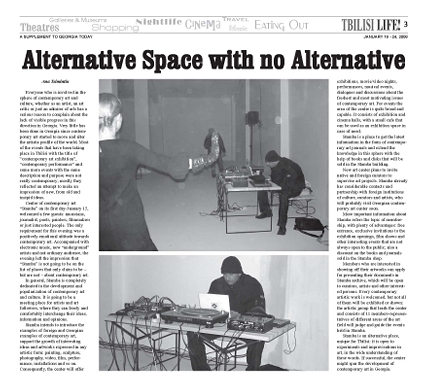






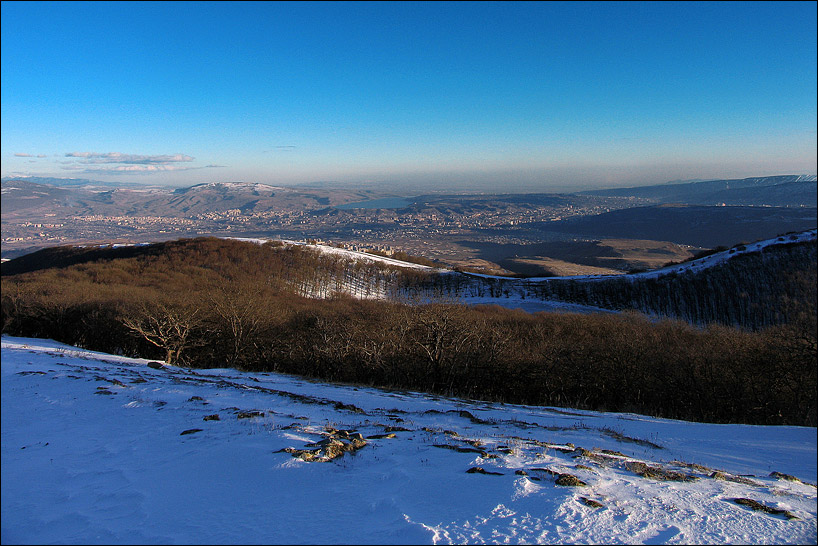

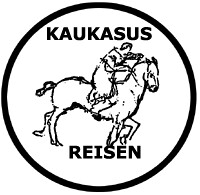



 Patricia with her Mom in Georgia
Patricia with her Mom in Georgia